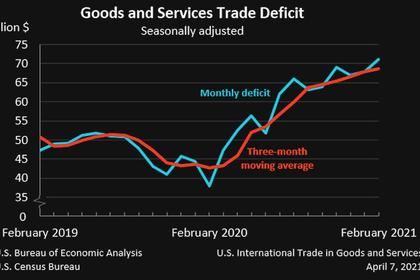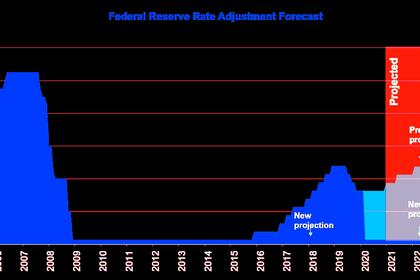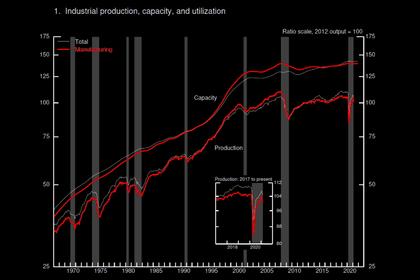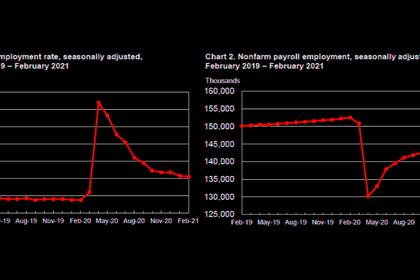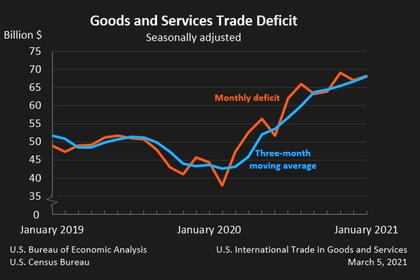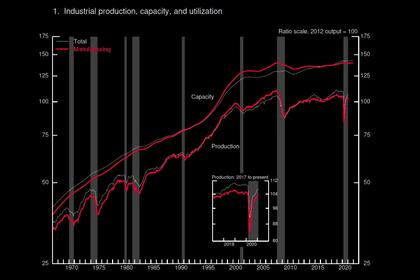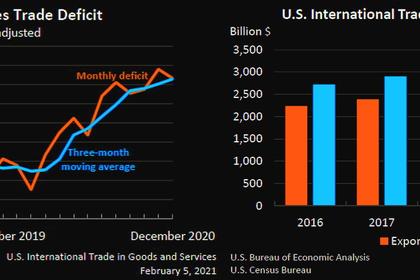
U.S. INDUSTRIAL PRODUCTION UP 1.4%
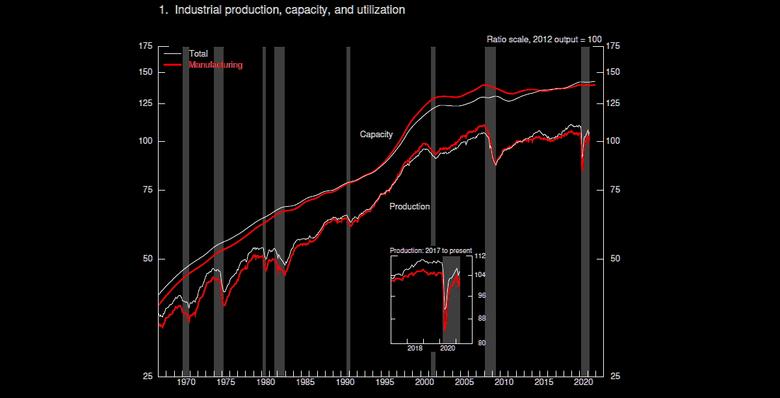
U.S. FRB - April 15, 2021- In March, total industrial production increased 1.4 percent. The gain in March followed a drop of 2.6 percent in February, which largely resulted from widespread outages related to severe winter weather in the south central region of the country. For the first quarter as a whole, total industrial production rose 2.5 percent at an annual rate. In March, manufacturing production and mining output increased 2.7 percent and 5.7 percent, respectively. The output of utilities dropped 11.4 percent, as the demand for heating fell because of a swing in temperatures from an unseasonably cold February to an unseasonably warm March.
At 105.6 percent of its 2012 average, total industrial production in March was 1.0 percent higher than its year-earlier level, but it was 3.4 percent below its pre-pandemic (February 2020) level. Capacity utilization for the industrial sector increased 1.0 percentage point in March to 74.4 percent, a rate that is 5.2 percentage points below its long-run (1972–2020) average.
Market Groups
Almost all market groups posted gains in March. The indexes for defense and space equipment, for construction supplies, and for nondurable materials each increased more than 4 percent. In addition, durable consumer goods, non-energy nondurable consumer goods, business equipment, and durable materials all posted gains of between 1-1/2 percent and 3 percent.
The step-down in utilities held back output for other market groups. The index for consumer energy products dropped about 10 percent, while the index for business supplies edged down. The index for energy materials rose 0.7 percent, as gains in crude oil and natural gas extraction offset the loss from utilities.
Industry Groups
Manufacturing output increased 2.7 percent in March, following a decline of 3.7 percent in February. For the first quarter, factory output advanced 1.9 percent at an annual rate. In March, the indexes for durable and nondurable manufacturing increased 3.0 percent and 2.6 percent, respectively, while the index for other manufacturing (publishing and logging) was unchanged. All major categories of durables registered increases, most of which were between 2 percent and 3 percent. The output of motor vehicles and parts rose 2.8 percent in March after falling 10 percent in February. Shortages of semiconductors held down vehicle production in both months, while cold weather also curbed production in February.
Among nondurables, all major industry categories recorded gains except plastics and rubber products. The petroleum and coal products industry and the chemicals industry registered gains of 5.7 percent and 4.1 percent, respectively, after posting declines in February because of severe weather. The recovery in chemicals was incomplete in March, however, as some factories remained offline because of weather-related damage sustained during February. The indexes for all other nondurable goods industries increased between 0.9 percent and 3.0 percent in March.
The drop of 11.4 percent for utilities in March was the largest in the history of this index (since 1972). Mining production increased 5.7 percent; oil and gas extraction accounted for most of the gain.
Capacity utilization for manufacturing increased 1.9 percentage points in March to 73.8 percent. The operating rate for mining increased 4.5 percentage points to 82.2 percent, while the operating rate for utilities decreased 9.0 percentage points to 68.8 percent; both rates remained below their long-run averages.
Revision of Industrial Production and Capacity Utilization
The Federal Reserve Board plans to issue its annual revision to the indexes of industrial production (IP) and the related measures of capacity utilization in the second quarter of 2021. New annual benchmark data for manufacturing for 2017 through 2019 will be incorporated, as well as other annual data, including information on the mining of metallic and nonmetallic minerals (except fuels). The weights for market-group splits of the industry-level indexes will be updated with information from the 2012 benchmark input-output accounts from the U.S. Bureau of Economic Analysis. The updated IP indexes will include revisions to the monthly production indicator (either product data or input data) and to seasonal factors for each industry. In addition, the estimation methods for some series may be changed. Any modifications to the methods for estimating the output of an industry will affect the index from 1972 to the present.
Capacity and capacity utilization will be revised to incorporate data for manufacturing through the fourth quarter of 2020 from the U.S. Census Bureau's Quarterly Survey of Plant Capacity Utilization, along with new data on capacity from the U.S. Geological Survey, the U.S. Department of Energy, and other organizations.
Note. The statistics in this release cover output, capacity, and capacity utilization in the U.S. industrial sector, which is defined by the Federal Reserve to comprise manufacturing, mining, and electric and gas utilities. Mining is defined as all industries in sector 21 of the North American Industry Classification System (NAICS); electric and gas utilities are those in NAICS sectors 2211 and 2212. Manufacturing comprises NAICS manufacturing industries (sector 31-33) plus the logging industry and the newspaper, periodical, book, and directory publishing industries. Logging and publishing are classified elsewhere in NAICS (under agriculture and information respectively), but historically they were considered to be manufacturing and were included in the industrial sector under the Standard Industrial Classification (SIC) system. In December 2002 the Federal Reserve reclassified all its industrial output data from the SIC system to NAICS.
-----
Earlier:
